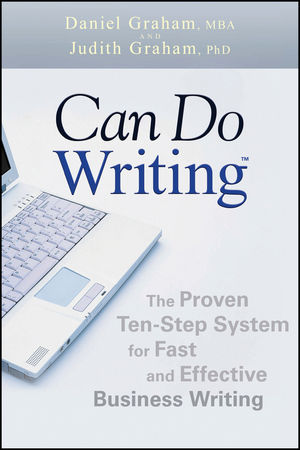Can Do Writing: The Proven Ten-Step System for Fast and Effective Business WritingISBN: 978-0-470-44979-0
Paperback
208 pages
April 2009
 This is a Print-on-Demand title. It will be printed specifically to fill your order. Please allow an additional 10-15 days delivery time. The book is not returnable.
|
||||||
About the Authors.
Introduction Can Do Writing.
Skillset: Analysis.
Step 1 Analyze Purpose and Audience.
1.1 What Result Do You Want from the Document?
1.2 Who Is the Audience?
1.3 What Does the Audience Do with the Information?
1.4 What Information Does the Audience Need?
1.5 Does the Audience Know Little or Much About the Information?
1.6 Does the Audience Need Proof?
1.7 Plan How to Write to Multiple Audiences.
Step 2 Write Your Document’s Five-Part Purpose Statement.
2.1 Decide the Type of Document or Oral Communication to Use.
2.2 Pick a Verb That Describes What the Document Does.
2.3 Assemble the Five Parts into a Purpose Statement.
2.4 Use the Purpose Statement to Settle Controversies.
Purpose Statements Make History.
Practice Steps 1 and 2 Using a Case Study.
Step 3 Select Facts.
3.1 Use the Purpose Statement As You Select Facts.
Step 4 Organize Your Points in a Sentence Outline.
4.1 Write Your Points Using Short Words in Short Sentences.
4.2 Evaluate Points to Eliminate Irrelevancies and Redundancies.
4.3 Order the Points.
Practice Steps 1 through 4 Using a Case Study.
Skillset: Composing the Draft.
Step 5 Compose the Draft.
5.1 Compose the Draft Body.
5.2 Compose the Draft Conclusion.
5.3 Compose the Draft Introduction.
5.4 If Necessary, Compose the Draft Executive Summary.
5.5 If Necessary, Compose the Draft Abstract.
Skillset: Editing.
Step 6 Review the Draft for Organization and Logic.
6.1 Test Organization by Answering Three Questions.
6.2 Use Sentence Outlining Techniques to Improve Organization.
6.3 Test Logic by Answering Five Questions.
Step 7 Edit for Coherence.
7.1 Repeat Key Words throughout Your Document.
7.2 Ensure That Each Paragraph Begins with a Point.
7.3 Use Transition Words.
7.4 Use Vertical Lists for Series of Like Items.
7.5 Ensure Your Graphics Make a Point.
7.6 Apply Visual Devices.
Step 8 Edit for Clarity.
8.1 Use Concrete and Specifi c Words.
8.2 Use Active Voice.
8.3 Simplify Tense: Stay in Present Tense When Possible.
8.4 Avoid the Helping Verbs Would, Should, and Could.
8.5 Identify and Replace Ambiguous Pronouns.
8.6 Use Standard English Words.
8.7 Check Sentences for Misplaced or Dangling Modifi ers.
Step 9 Edit for Economy.
9.1 Cut Useless Verbs.
9.2 Cut Useless Prepositions.
9.3 Cut Who, Which, and That.
9.4 Cut Useless Repetition.
9.5 Cut Redundancy.
9.6 Cut Useless Comments.
9.7 Cut Useless Modifi ers.
Step 10 Edit for Readability.
10.1 Measure Readability Using the Gunning Fog Index.
10.2 Replace Long Words with Short Words.
10.3 Break Long Sentences.
Conclusion Congratulations!
Index.



